AutoPage Category mystic Page 1 of 1
This page is automagically created and paginated for each category available in the posts on this site
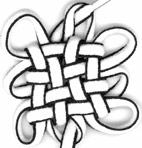
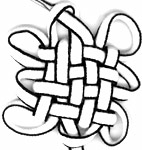 Now the illustration/instructions for Ashley #589 is of the line and circle (indicating unders) variety. It is extremely difficult to visualize from that, especially for a knot of this complexity. He recommends enlarging the diagram and pinning everything down very carefully. Well, I was winging it freehand, and I’m pretty sure it’s not right, at least the “back side” looks like there’s a mistake (see right). The “front” side on the other hand, looks reasonable except that the loose ends extending through the loops are back to front versus front to back as in the diagram.
Now the illustration/instructions for Ashley #589 is of the line and circle (indicating unders) variety. It is extremely difficult to visualize from that, especially for a knot of this complexity. He recommends enlarging the diagram and pinning everything down very carefully. Well, I was winging it freehand, and I’m pretty sure it’s not right, at least the “back side” looks like there’s a mistake (see right). The “front” side on the other hand, looks reasonable except that the loose ends extending through the loops are back to front versus front to back as in the diagram.
Read more
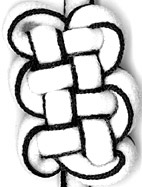
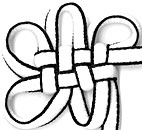 Unlike the inline square flower knot (see left), Ashley #588, a rectangular knot is not simply the 1x2 mystic knot (see right) with one end passed through the body of the knot to give a half-hearted extra ear (although it could certainly be done that way). The pass-through occurs earlier and still has no structural support, so the ears still need to be either “closed” or sewn in order that casual handling not destroy the knot.
Unlike the inline square flower knot (see left), Ashley #588, a rectangular knot is not simply the 1x2 mystic knot (see right) with one end passed through the body of the knot to give a half-hearted extra ear (although it could certainly be done that way). The pass-through occurs earlier and still has no structural support, so the ears still need to be either “closed” or sewn in order that casual handling not destroy the knot.
Read more
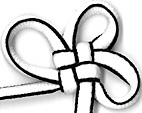 While the flower knot, when
considered as a polygonal knot, is a family unto itself with many
(many!) variations starting with the number of petals
(ears) and the ways that the structural loops
interlace, the basic square flower knot is also the basic unit of the
mystic knot (see right). Now flower knots can be chained
together via their ears as in the case of the ru-yi knot, but if you
instead extend the structural loops and weave through
them appropriately, you begin to build up a mystic knot.
While the flower knot, when
considered as a polygonal knot, is a family unto itself with many
(many!) variations starting with the number of petals
(ears) and the ways that the structural loops
interlace, the basic square flower knot is also the basic unit of the
mystic knot (see right). Now flower knots can be chained
together via their ears as in the case of the ru-yi knot, but if you
instead extend the structural loops and weave through
them appropriately, you begin to build up a mystic knot.
Read more
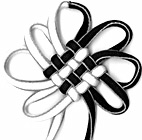
 In the next post, I’ll illustrate the relationship, but for now let me just say that the square form of the flower knot (see right) is the basic unit of the mystic knot (see left). The Ashley Book of Knots (also known as Ashley’s or ABoK) has much to say on the topic of mystic knots, but not in those words (Ashley calls this knot family the Chinese butterfly knots), so let’s extract them and put them in one post for easy reference, shall we? I’m making pronouncements based on visual inspection and could easily be wrong, I’ll tie them and post the pictures later, correcting as I go if necessary…
In the next post, I’ll illustrate the relationship, but for now let me just say that the square form of the flower knot (see right) is the basic unit of the mystic knot (see left). The Ashley Book of Knots (also known as Ashley’s or ABoK) has much to say on the topic of mystic knots, but not in those words (Ashley calls this knot family the Chinese butterfly knots), so let’s extract them and put them in one post for easy reference, shall we? I’m making pronouncements based on visual inspection and could easily be wrong, I’ll tie them and post the pictures later, correcting as I go if necessary…
Read more
 The mystic knot is the pan chang knot is the endless knot and is also less commonly known as the coil knot and the temple knot. Pan chang is, of course, the romanization of the Chinese name. The best literal translation of pan chang is probably coil, but the word evokes a much different image for most, I would suspect.
The mystic knot is the pan chang knot is the endless knot and is also less commonly known as the coil knot and the temple knot. Pan chang is, of course, the romanization of the Chinese name. The best literal translation of pan chang is probably coil, but the word evokes a much different image for most, I would suspect.
Read more

 Now the illustration/instructions for Ashley #589 is of the line and circle (indicating unders) variety. It is extremely difficult to visualize from that, especially for a knot of this complexity. He recommends enlarging the diagram and pinning everything down very carefully. Well, I was winging it freehand, and I’m pretty sure it’s not right, at least the “back side” looks like there’s a mistake (see right). The “front” side on the other hand, looks reasonable except that the loose ends extending through the loops are back to front versus front to back as in the diagram.
Now the illustration/instructions for Ashley #589 is of the line and circle (indicating unders) variety. It is extremely difficult to visualize from that, especially for a knot of this complexity. He recommends enlarging the diagram and pinning everything down very carefully. Well, I was winging it freehand, and I’m pretty sure it’s not right, at least the “back side” looks like there’s a mistake (see right). The “front” side on the other hand, looks reasonable except that the loose ends extending through the loops are back to front versus front to back as in the diagram.


